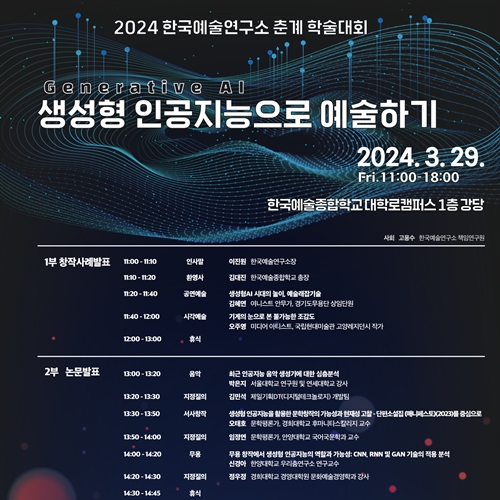
On 29 March at the Daehak-ro campus, the Korean
National Research Center for the Arts (KRECA) affiliated with K-Arts held the spring
academic symposium on “Doing Art with Generative AI.”
In part 1, there were presentations on the cases of creative activities by artists in performing art and visual art. Kim Hye-yeon, a choreographer of Yonist, shared her concerns about how AI perceives the human body and how it can be related to technologies of “body” and “body senses.” Media artist Oh Ju-yeong explored the limitations and potential, employing engineering research and interactive technology, and presented on “Impossible Bird’s Eye View in the Machine Eye.”
Part 2 consisted of the presentation of papers. Park Eunji, an instructor at Yonsei University, traced the history of AI music generators and sought their future potential. Oh Tae-ho, a professor of Humanitas College at Kyung Hee University, presented “A Thought on Potential and Presentness of Writing Literature Using Generative AI – Focused on Short Story Collection, ‘Manifesto.’” Oh analyzed 7 short stories in the collection in detail and examined the presentness of the creativities using AI and the degree of collaboration with chat GPT from the text-structuralism perspective. Shin Kyung-a, a research professor at Hanyang University, presented “The Role and Potential of Generative AI in Creative Dance: A Case Analysis of Application of CNN, RNN and GAN Technologies.”
Jeon Byeong-won, the director of the Future Film Research Center, presented “Icon, Sign, and AI Cinema: Film Iconology and Film Semiotics for AI Cinema,” and Yun Nara, a visiting professor at Inha University presented “From an Artist or Craftsperson To the General Director in the Generative AI Era.” Pae Jun, an assistant professor at Suwon University, studied if the RVC model could be applied to the pansori in gugak by experimenting, demonstrating, and evaluating the translation of pansori master Kim Sohee’s voice into voices of different genres, insinuating the possibilities of new artistic expressions and creativities.
Part 3 was a discussion session. Lee Jinwon, the director of the KRECA, stated, “Through ‘Doing Art with Generative AI,’ we hope to share the artists’ actual intriguing cases and think about the question of doing brand new arts using generative AI while looking into technologies, procedures, methods, roles expected for AI or artists, and evidence from experiments.”